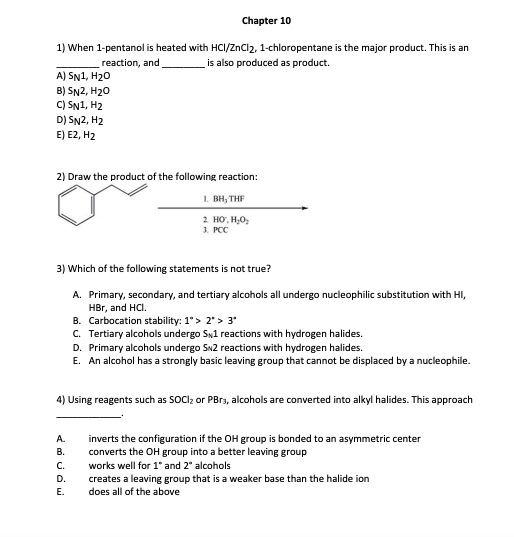1) When 1-pentanol is heated with HCI/ZnCl2, 1-chloropentane is the major product. This is an reaction, and, is also produced as product. A) SN1, H₂O B) SN2, H₂O C) SN1, H2 D) SN2, H2 E) E2, H2 2) Draw the product of the following reaction: 1. BH, THE 2. HƠ, H,9, 3. PCC 3) Which of the following statements is not true? A. Primary, secondary, and tertiary alcohols all undergo nucleophilic substitution with HI, HBr, and HCl. B. Carbocation stability: 1°> 2*> 3* C. Tertiary alcohols undergo SN1 reactions with hydrogen halides. D. Primary alcohols undergo SN2 reactions with hydrogen halides. E. An alcohol has a strongly basic leaving group that cannot be displaced by a nucleophile. 4) Using reagents such as SOCI₂ or PBrs, alcohols are converted into alkyl halides. This approach A. inverts the configuration if the OH group is bonded to an asymmetric center
1) When 1-pentanol is heated with HCI/ZnCl2, 1-chloropentane is the major product. This is an reaction, and, is also produced as product. A) SN1, H₂O B) SN2, H₂O C) SN1, H2 D) SN2, H2 E) E2, H2 2) Draw the product of the following reaction: 1. BH, THE 2. HƠ, H,9, 3. PCC 3) Which of the following statements is not true? A. Primary, secondary, and tertiary alcohols all undergo nucleophilic substitution with HI, HBr, and HCl. B. Carbocation stability: 1°> 2*> 3* C. Tertiary alcohols undergo SN1 reactions with hydrogen halides. D. Primary alcohols undergo SN2 reactions with hydrogen halides. E. An alcohol has a strongly basic leaving group that cannot be displaced by a nucleophile. 4) Using reagents such as SOCI₂ or PBrs, alcohols are converted into alkyl halides. This approach A. inverts the configuration if the OH group is bonded to an asymmetric center
Chemistry
10th Edition
ISBN:9781305957404
Author:Steven S. Zumdahl, Susan A. Zumdahl, Donald J. DeCoste
Publisher:Steven S. Zumdahl, Susan A. Zumdahl, Donald J. DeCoste
Chapter1: Chemical Foundations
Section: Chapter Questions
Problem 1RQ: Define and explain the differences between the following terms. a. law and theory b. theory and...
Related questions
Question
Only need answer to #1 and #4 please use image

Transcribed Image Text:1) When 1-pentanol is heated with HCI/ZnCl2, 1-chloropentane is the major product. This is an
is also produced as product.
reaction, and
A) SN1, H₂O
B) SN2, H₂O
C) SN1, H₂
D) SN2, H2
E) E2, H2
Chapter 10
2) Draw the product of the following reaction:
1. BH, THE
2 HỒ, HyOy
3. PCC
3) Which of the following statements is not true?
A. Primary, secondary, and tertiary alcohols all undergo nucleophilic substitution with HI,
HBr, and HCI.
B. Carbocation stability: 1*> 2* > 3*
C. Tertiary alcohols undergo SN1 reactions with hydrogen halides.
D. Primary alcohols undergo SN2 reactions with hydrogen halides.
E. An alcohol has a strongly basic leaving group that cannot be displaced by a nucleophile.
4) Using reagents such as SOCI₂ or PBrą, alcohols are converted into alkyl halides. This approach
A.
B.
C.
D.
E.
inverts the configuration if the OH group is bonded to an asymmetric center
converts the OH group into a better leaving group
works well for 1" and 2* alcohols
creates a leaving group that is a weaker base than the halide ion
does all of the above
Expert Solution
This question has been solved!
Explore an expertly crafted, step-by-step solution for a thorough understanding of key concepts.
This is a popular solution!
Trending now
This is a popular solution!
Step by step
Solved in 4 steps with 2 images

Knowledge Booster
Learn more about
Need a deep-dive on the concept behind this application? Look no further. Learn more about this topic, chemistry and related others by exploring similar questions and additional content below.Recommended textbooks for you

Chemistry
Chemistry
ISBN:
9781305957404
Author:
Steven S. Zumdahl, Susan A. Zumdahl, Donald J. DeCoste
Publisher:
Cengage Learning

Chemistry
Chemistry
ISBN:
9781259911156
Author:
Raymond Chang Dr., Jason Overby Professor
Publisher:
McGraw-Hill Education

Principles of Instrumental Analysis
Chemistry
ISBN:
9781305577213
Author:
Douglas A. Skoog, F. James Holler, Stanley R. Crouch
Publisher:
Cengage Learning

Chemistry
Chemistry
ISBN:
9781305957404
Author:
Steven S. Zumdahl, Susan A. Zumdahl, Donald J. DeCoste
Publisher:
Cengage Learning

Chemistry
Chemistry
ISBN:
9781259911156
Author:
Raymond Chang Dr., Jason Overby Professor
Publisher:
McGraw-Hill Education

Principles of Instrumental Analysis
Chemistry
ISBN:
9781305577213
Author:
Douglas A. Skoog, F. James Holler, Stanley R. Crouch
Publisher:
Cengage Learning

Organic Chemistry
Chemistry
ISBN:
9780078021558
Author:
Janice Gorzynski Smith Dr.
Publisher:
McGraw-Hill Education

Chemistry: Principles and Reactions
Chemistry
ISBN:
9781305079373
Author:
William L. Masterton, Cecile N. Hurley
Publisher:
Cengage Learning

Elementary Principles of Chemical Processes, Bind…
Chemistry
ISBN:
9781118431221
Author:
Richard M. Felder, Ronald W. Rousseau, Lisa G. Bullard
Publisher:
WILEY